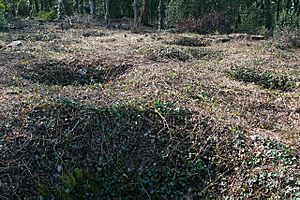Prehistoric storage pits facts for kids
Storage pits are special holes dug underground. People in the past used them to keep important things safe. They stored seeds for planting next year's crops. They also kept extra food away from insects and rodents. These underground pits were sometimes lined with materials like stone or bark. They were often sealed tightly with adobe (a type of mud brick).
Ancient Storage Pits
People have used storage pits for thousands of years. These pits helped ancient communities survive. They made sure there was enough food, especially during tough times.
Sannai-Maruyama Site
The Sannai-Maruyama Site is in Aomori, Aomori Prefecture, Japan. This site has many old storage pits. They were used by hunter-gatherers a long time ago. This was around 3900 BC to 2900 BC. At this time, people started to live in settled villages instead of moving around. Large storage pits were built underground. This helped to hide them. Many groups of people who moved around often used this method.
Worlebury Camp Pits

The Worlebury Camp is an Iron Age hill fort in Somerset, England. Here, archaeologists found 93 storage pits. These pits were dug into the hard bedrock. Most of them were inside the fort's walls.
People used these pits to store grain. Scientists found kernels of barley and wheat inside them. They also found pieces of old pots. Other items found include burned pieces of woven baskets. Sling stones and spindle whorls (used for spinning thread) were also discovered. These items date back to the 2nd or 1st century BC.
Māori Storage Pits
In New Zealand, you can still see many Māori storage pit sites. The Māori people dug these pits into soft rock or earth. They were especially common in Maori Pa (hill forts).
The Māori name for a storage pit is rua. These pits were important for storing kumara (sweet potato). Kumara was the main vegetable crop for the Māori after about the year 1500. Sometimes, Māori storage pits can look like other types of pits. For example, some pits were dug to get material for drainage. This material helped the soil drain better for growing kumara. In 2012, storage pits were found on the banks of the Waikato River near the Waikato Museum.


